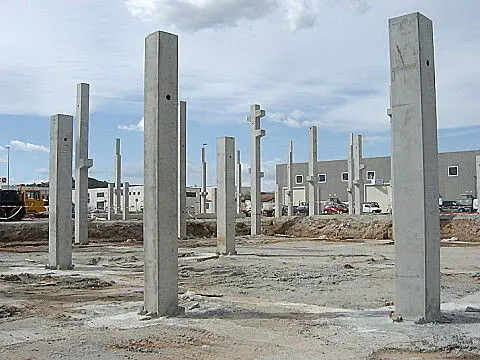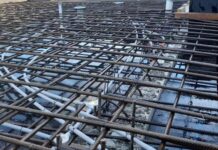Loads from slabs and beams are transferred to the foundations through the columns. In typical cases, columns are usually rectangular or circular in shape. Normally, they are usually classified as short or slender depending on their slenderness ratio, and this in turn influences their mode of failure. Slender columns are likely to fail by buckling than by crushing.
Columns are either subjected to axial, uniaxial, or biaxial loads depending on the location and/or loading condition. Eurocode 2 demands that we include the effects of imperfections in structural design of columns. Column design is covered in section 5.8 of EN 1992-1-1:2004 (EC2).
Slender Columns Requirements in EC2
Clause 5.8.2 of EN 1992-1-1 deals with members and structures in which the structural behaviour is significantly influenced by second order effects (e.g. columns, walls, piles, arches and shells). Global second order effects are more likely to occur in structures with a flexible bracing system.
Column design in EC2 generally involves determining the slenderness ratio (λ), of the member and checking if it lies below or above a critical value λlim. If the column slenderness ratio lies below (λlim), it can simply be designed to resist the axial action and moment obtained from an elastic analysis, but including the effect of geometric imperfections. These are termed first order effects. However, when the column slenderness exceeds the critical value, additional (second order) moments caused by structural deformations can occur and must also be taken into account.
So in general, second order effects may be ignored if the slenderness λ is below a certain value λlim.
λlim = (20.A.B.C)/√n ——- (1)
Where:
A = 1/(1 + 0.2ϕef) (if ϕef is not known, A = 0.7 may be used)
B = 1+ 2ω (if ω is not known, B = 1.1 may be used)
C = 1.7 – rm (if rm is not known, C = 0.7 may be used)
Where; ϕef = effective creep ratio (0.7 may be used)
ω = Asfyd / (Acfcd); mechanical reinforcement ratio;
As is the total area of longitudinal reinforcement
n = NEd / (Acfcd); relative normal force
rm = M01/M02; moment ratio
M01, M02 are the first order end moments, |M02| ≥ |M01|
If the end moments M01 and M02 give tension on the same side, rm should be taken positive (i.e. C ≤ 1.7), otherwise negative (i.e. C > 1.7). For braced members in which the first order moments arise only from or predominantly due to imperfections or transverse loading rm should be taken as 1.0 (i.e. C = 0.7).
Also, clause 5.8.3.1(2) says that for biaxial bending, the slenderness criterion may be checked separately for each direction. Depending on the outcome of this check, second order effects (a) may be ignored in both directions, (b) should be taken into account in one direction, or (c) should be taken into account in both directions.
Solved Example
Let us consider the structure shown below. The effects of actions on column member BC is as shown below. It is required to design the column using the following data;
fck = 25 N/mm2, fyk = 460 N/mm2, Concrete cover = 35mm
Second moment of area of beam AB = (0.3 × 0.63)/12 = 0.0054 m4
Stiffness of beam AB (since E is constant) = 4I/L = (4 × 0.0054) / 6 = 0.0036
Second moment of area of column BC = (0.3 × 0.63)/12 = 0.0054 m4
Stiffness of column BC (since E is constant) = 4I/L = (4 × 0.0054)/7.5 = 0.00288
Remember that we will have to reduce the stiffness of the beams by half to account for cracking;
Therefore, k1 = 0.00288/0.0018 = 1.6
Since the minimum value of k1 and k2 is 0.1, adopt k1 as 1.6. Let us take k2 as 1.0 for base designed to resist moment.
Take the unrestrained clear height of column as 7000mm
lo = 0.5 × 7000√[(1 + (1.6/(0.45 + 1.6))) × (1 + (1.0/(0.45+ 1.0)))] = 6071 mm
Radius of gyration i = h/√12 = 600/√12 = 173.205
Slenderness ratio λ = 6071/173.205 = 35.051
Critical Slenderness for the x-direction
λlim = (20.A.B.C)/√n
A = 0.7
B = 1.1
C = 1.7 – M01/M02 = 1.7 – (-210/371) = 2.266
n = NEd / (Ac fcd)
NEd = 3500 × 103 N
Ac = 300 × 600= 180000 mm2
fcd = (αcc fck)/1.5 = (0.85 × 25)/1.5 = 14.167 N/mm2
n = (3500 × 103) / (180000 × 14.167) = 1.3725
λlim = (20 × 0.7 × 1.1 × 2.266 )/√1.3725 = 29.786
Since 29.786 < 35.051, second order effects need to be considered in the design
Design Moments
MBot = 210 KNm, MTop = 371 KNm
ei is the geometric imperfection = (θi l0/2) = [(1/200) × (6071/2)] = 15.1775 mm
eiNEd = 15.1775 × 10-3 × 3500 = 53.121 KNm
First order end moment
M01 = MBot + eiNEd = -210 + 53.121 = -156.879 KNm
M02 = MTop + eiNEd = 371 + 53.121 = 424.121 KNm
Equivalent first order moment M0Ed
M0Ed = (0.6M02 + 0.4M01) ≥ 0.4M02 = 0.4 × 424.121 = 169.648 KNm
M0Ed= (0.6 × 424.121 – 0.4 × 156.879) = 191.721 KNm
Nominal second order moment M2
Specified concrete cover = 35mm
Diameter of longitudinal steel = 32 mm
Diameter of links = 10 mm
Thus, the effective depth (d) = h – Cnom – ϕ/2 – ϕlinks
d = 600 – 35 – 16 – 10 = 539 mm
1/r0 = εyd/(0.45 d)
εyd = fyd/Es = (460 /1.15) / (200 × 103) = 0.002
1/r0 = 0.002/(0.45 × 539) = 8.2457 × 10-6
β = 0.35 + fck/200 – λ/150 (λ is the slenderness ratio)
β = 0.35 + (25/200) – (35.051/150) = 0.2413
Kϕ = 1 + βϕef ≥ 1.0 (ϕef is the effective creep ratio, assume 0.87)
Kϕ = 1 + (0.2413 × 0.87) = 1.2099 ≥ 1.0
Assume Kr = 0.8
1/r = Kr.Kϕ. 1/r0 = 0.8 × 1.2099 × 8.2457 × 10-6 = 7.981 × 10-6
e2 is the deflection = (1/r) (l02) / 10 = 7.981 × 10-6 × 60712 / 10 = 29.415 mm
M2 = NEd.e2 = 3500 × 29.415 × 10-3 = 102.954 KNm
Design Moment MEd
MEd = maximum of {M0Ed + M2; M02; M01 + 0.5M2}
MEd = maximum of {191.721 + 102.954 = 294.675 kNm; 424.121 kNm; -156.879 + (0.5 × -102.954) = -208.356 kNm}
Longitudinal Steel Area
d2 = Cnom + ϕ/2 + ϕlinks
d2 = 35 + 16 + 10 = 61 mm
d2/h = 61/600 = 0.1016
Reading from chart No 2; d2/h = 0.10;
MEd/(fck bh2) = (424.121 × 106) / (25 × 300 × 6002) = 0.1571
NEd/(fck bh) = (3500 × 103) / (25 × 300 × 600) = 0.777
From the chart, (AsFyk)/(bhfck) = 0.53
Area of longitudinal steel required (As) = (0.53 × 25 × 300 × 600)/460 = 5185 mm2
Provide 6Y32 + 2Y20 (ASprov = 5452 mm2)
As,min = (0.1 NEd)/fyd = (0.1 × 3500 × 1000) / 400 = 875mm2, 0.002bh = 0.002 × 300 × 600 = 360 mm2
As,max = 0.04bh = 0.04 × 300 × 600 = 7200 mm2
Links
Minimum size = 0.25ϕ = 0.25 × 32 = 8mm < 6mm
We are adopting Y10mm as links
Spacing adopted = 300mm less than {b, h, 20ϕ, 400mm} Provide Y10 @ 300 mm links
Thank you for reading
We love you, and we will keep working hard for you.
Like our Facebook page on www.facebook.com/structville











best example with best explanation!!!
Would like to ask From chart , why (As.fyk)/bhfck= 0.53 , is it not 0.71 from the reading then As=6945mm2
Provide 8×32 + 2×20 (From As=7062mm2)
Would like to ask From the Chart , why is (Asfyk/bhfck )=53 , is it not 71 then As=6945mm2
Provide 8×32 + 2×20 (From given As=7062mm2) ?
is this for braced or unbraced